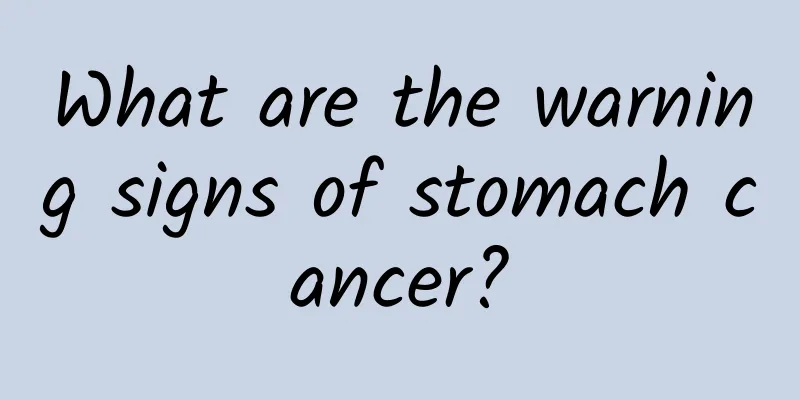What are the warning signs of stomach cancer?

|
Almost half of the world's gastric cancer patients are in China, claiming nearly 400,000 lives each year, or almost one person dies from gastric cancer every minute. However, although the occurrence of gastric cancer is very hidden, some clues can still be found in the early stages. However, these inconspicuous warning signals are often ignored by people, resulting in delayed treatment of the disease. What are the warning signs of gastric cancer? 1. Early symptoms of gastric cancer 1: sore throat The cardia is the uppermost part of the stomach, connected to the esophagus. Tumors occurring at the cardia account for about 20% of gastric cancers. The lesser curvature gastric angle is a more common site for gastric cancer, accounting for about 40%, and tumors occurring in the gastric body account for about 20%. The esophagus is lined with squamous epithelium, which is different from the stomach and cannot tolerate the stimulation of gastric acid. Therefore, the mucosa of the cardia, where the esophagus and stomach meet, is very fragile. Studies have shown that the incidence of cardia cancer is positively correlated with the incidence of gastroesophageal reflux disease. The symptoms of sore throat are caused by irritating food and gastric acid refluxed from the stomach. Some people call the cardia cancer esophageal cancer, cancer at the lower end of the esophagus, and some people call it stomach cancer. In fact, both are correct. The cardia is connected to the esophagus and the stomach. The cardia is the most likely place for cancer to grow. The esophagus is not of the same thickness. It is thinner at the point where it connects to the cardia than other parts. Every time we swallow a mouthful of food and it is about to enter the stomach, the cardia will open, put the food in, and then close again. The cardia cannot be open all the time, otherwise it will cause acid reflux. The esophagus is neutral, while the intestines are alkaline. Only the stomach is acidic, and the acidity of gastric juice is more acidic than vinegar. Everyone has the experience of hiccups and acid reflux. The reason why the stomach is acidic is to digest food. If the cardia is not closed, the food and gastric juice in the stomach will flow back. The refluxed gastric juice is as acidic as vinegar, and it rinses in the esophagus like a pool cleaning liquid, irritating the esophagus every day. Therefore, the location of the cardia is a place where cancer is prone to occur. 2. Early symptoms of gastric cancer 2: stomach bloating and pain Stomach bloating and pain is another signal that may be easily overlooked in the early and advanced stages of gastric cancer. It is characterized by dull pain with bloating as the main symptom. This is because the initial inflammation is in the mucosal layer, which is controlled by visceral nerves. The nerves of the viscera are different from the nerves in the skin, and the positioning of the visceral nerves is inaccurate. Therefore, the pain caused by gastroenteritis, appendicitis, gastric ulcer, early and advanced gastric cancer is dull, dull, and muffled. This pain is characterized by: The bloating and pain worsen after meals, are not easy to relieve, continue to worsen, and have no regular pattern. When gastric cancer infiltrates and penetrates the stomach wall, gastric perforation occurs, and the contents of the stomach enter the abdominal cavity, peritonitis is likely to occur. Moreover, since the innervation of the parietal peritoneum is the somatic nerve innervation, which is sensitive to pain, it will produce unbearable severe pain like a knife cut. 3. Early symptoms of gastric cancer 3: nausea and vomiting If the tumor occurs at the pyloric location and food emptying is blocked, symptoms of nausea and vomiting may occur. Long-term neglect of diet and frequent consumption of cold and hard foods may cause stomach lesions. The stomach is very fragile and is afraid of grinding, heat, and strong tastes. In terms of diet, you must eat some foods that are good for the stomach, and you must eat healthily and regularly. Three meals a day, with a combination of liquid and dry, coarse and fine, to protect the health of the stomach. 4. What other early signals are there? In 2016, the National Gastric Cancer Collaborative Group conducted a clinical analysis of 400 patients with early gastric cancer. The early signals found are: 1. Upper abdominal pain accounted for 83.3%; 2. Loss of appetite accounted for 39.5%; 3. Stomach bloating accounts for 37.8%; 4. Vomiting acid accounts for 37.5%; 5. Upper abdominal discomfort accounted for 36%; 6. 35.8% of the cases are emaciated. These symptoms are no different from common stomach problems. If you are not careful, you can make big mistakes and delay detection and treatment. Therefore, once the above discomfort occurs, a gastroscopy should be performed in time. |
<<: Are you one of the people at high risk of gastric cancer?
>>: Why is gastric cancer becoming younger and younger?
Recommend
What should I pay attention to when having labiaplasty?
Women often experience enlarged labia. Currently,...
Can I eat donkey-hide gelatin during menstruation?
Many female friends will take some tonics during ...
Four-dimensional color Doppler ultrasound left ventricle bright spot
People's heart function is originally a very ...
How to read the blood test report?
I went to the hospital for a cold and had my bloo...
What causes lower abdominal pain in women?
Due to the complex body structure of women, stoma...
Why is there blood in the vaginal discharge after menstruation?
Many people find that there is a problem with the...
What should pregnant women drink?
The diet of pregnant women during pregnancy is ve...
What causes bright red menstrual blood?
Menstruation is like a barometer, constantly remi...
What to do if uterine cysts grow
Cyst is a very complicated disease. Once it occur...
Girls' private parts eczema pictures
Private eczema is a type of eczema, which often o...
Is it painful to put on the Manlo Ring?
The Menlo Ring is a high-tech drug delivery ring ...
The safest contraceptive method for women
Although there are many contraceptive methods now...
How to massage the hard lumps in the milk?
If you find that your breasts are painful and fee...
Is it better to eat fruit before or after a meal? What fruit can be eaten on an empty stomach?
Fruit is a type of food that we eat every day, an...









